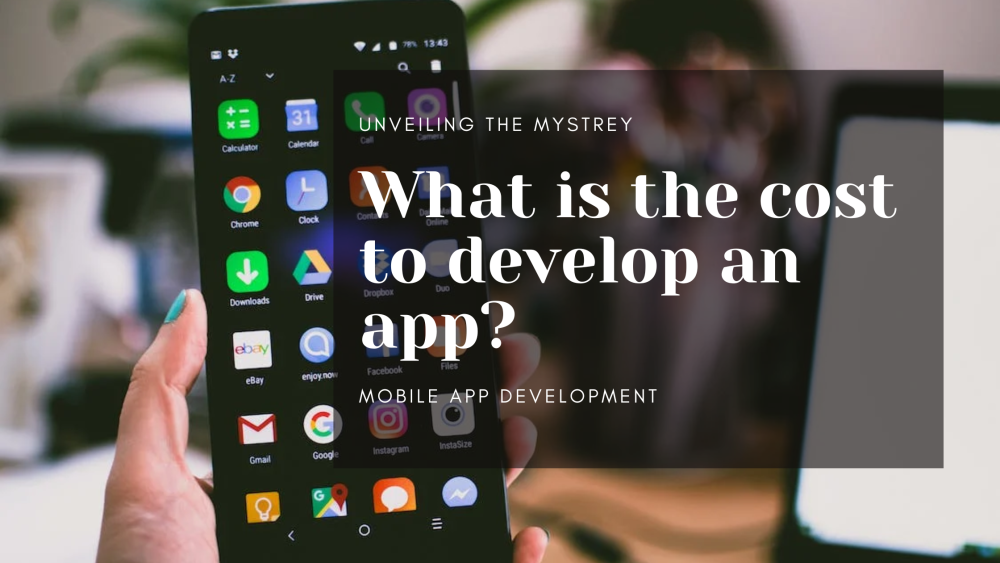Introduction: Navigating the Landscape of App Development Costs
Congratulations on coming up with a great app idea! You're probably wondering how much it will cost to develop your app. The answer is: it depends. There are a number of factors that will affect the cost of app development, including the following:
-
The complexity of your app
-
The features you want to include
-
The platform(s) you want to develop for
-
The experience and location of your development team
In general, you can expect to pay anywhere from $10,000 to $100,000 or more to develop a basic app. More complex apps can cost upwards of $1 million.
Table of Contents
Introduction: Navigating the Landscape of App Development Costs
Cost to Develop an App: Unraveling the Key Factors
App Complexity: A Major Player in Costs
Platform Selection: iOS, Android, or Both?
Design and User Experience: Investing in Appeal
Development Team: The Wizards Behind the Curtain
Features and Functionalities: Tailoring to User Needs
Testing and Quality Assurance: Ensuring Smooth Sailing
Post-Launch Maintenance: A Continuous Investment
Marketing and Launch: Getting Noticed
Q: Is there a ballpark figure for app development costs?
Q: Are there ongoing expenses after the app is launched?
Q: Can I develop an app on my own to save costs?
Q: How does app complexity impact the timeline?
Q: What's the advantage of outsourcing development?
Q: Is cross-platform development worth the extra cost?
In Conclusion: Navigating App Development Costs
Cost to Develop an App: Unraveling the Key Factors
Creating an app is a complex process that involves multiple steps, each with its own costs. Here's a closer look at each step:
-
App concept and design: This is where the idea for the app is born, and where the user interface and user experience are designed. This can be a costly step, as it requires the expertise of designers and developers.
-
App development: This is where the app's code is written and its functionality is built. This is another costly step, as it requires the expertise of developers.
-
App testing: This is where the app is tested to ensure that it works correctly and meets all requirements. This is an important step, as it can help to identify and fix any bugs before the app is released to the public.
-
App deployment: This is where the app is made available to users. This can be done through a variety of channels, such as the App Store or Google Play.
-
App maintenance: This is where the app is kept up-to-date and any bugs that are found are fixed. This is an ongoing process, as new bugs are constantly being discovered.
The total cost of creating an app will vary depending on the complexity of the app and the features that are included. However, it's important to keep in mind that all of the steps listed above will incur some costs.
App Complexity: A Major Player in Costs
The more complex your app, the more expensive it will be to develop. This is because complex apps require more features, which take more time and resources to code and test. Simple apps, on the other hand, are less expensive to develop. This is because they have fewer features and require less code and testing. Feature-rich apps like gaming platforms are the most expensive to develop because they are the most complex.
Platform Selection: iOS, Android, or Both?
The cost of developing an app is influenced by the platform(s) you choose. Developing for both iOS and Android typically costs more because the two platforms have different operating systems and user interfaces. This means that the app must be customized for each platform and tested on both to ensure that it works properly. The total cost of development can vary depending on the complexity of the app, the features that are included, and the number of platforms that it is developed for. However, developing an app for both iOS and Android can typically cost twice as much as developing an app for just one platform.
Here are some tips for choosing the right platform(s) for your app:
-
Consider your target audience. Which platform(s) do your target users use most often?
-
Think about your app's features. Which features are essential for your app to be successful?
-
Consider your budget. How much are you willing to spend on developing and maintaining your app?
-
Do your research. Read articles and blog posts about app development, and talk to other app developers to get their advice.
Design and User Experience: Investing in Appeal
A successful app needs to have two things: a visually appealing design and a seamless user experience. A well-designed app will grab users' attention and make them want to use it. It will also be easy to use, with a clear layout and simple language. A seamless user experience means that users can easily find the information or features they need. It also means that the app is responsive and doesn't crash or freeze. To create a successful app, you need to invest in skilled designers and user interface experts. They can help you create an app that is both visually appealing and user-friendly. This can be a costly investment, but it is one that is likely to pay off in the long run.
Development Team: The Wizards Behind the Curtain
Hiring skilled developers is essential for creating a successful app. Their expertise, experience, and location can all affect costs. Outsourcing to regions with lower labor costs is an option worth considering.
There are many benefits to outsourcing app development to a lower-cost region. First, it can save you a significant amount of money. The cost of living and labor is often much lower in developing countries, so you can get the same level of work done for a fraction of the price. Additionally, outsourcing can give you access to a wider pool of talented developers. There are many talented developers in developing countries who are eager to work on international projects. This can give you a competitive advantage in the app development market.
Of course, there are also some potential drawbacks to outsourcing app development. One is that there can be communication and cultural barriers. It's important to work with a reputable development company that has experience working with clients from your country. Additionally, you need to make sure that you have a clear understanding of the project requirements and that you are able to provide clear and concise feedback.
Overall, outsourcing app development to a lower-cost region can be a great way to save money and access a wider pool of talented developers. However, it's important to do your research and work with a reputable development company to avoid any potential problems.
Features and Functionalities: Tailoring to User Needs
The more features you add to a product, the more expensive it will be to develop. It's important to find a balance between offering a great user experience and keeping development costs down. You can do this by prioritizing features based on how important they are to users and how expensive they are to develop. It's also important to consider the long-term costs of maintaining and supporting additional features.
Here are some tips for striking a balance between features and cost:
-
Prioritize features based on how important they are to users.
-
Estimate the cost of developing each feature.
-
Consider the long-term costs of maintaining and supporting additional features.
-
Iterate on your product and add features based on user feedback.
-
Be prepared to cut features if they are not meeting expectations.
By following these tips, you can create a product that offers a great user experience without breaking the bank.
Testing and Quality Assurance: Ensuring Smooth Sailing
Quality assurance testers are essential for ensuring that your app works seamlessly and avoids costly delays and customer dissatisfaction. They catch bugs and glitches early on by running a variety of tests, including unit tests, integration tests, and system tests. They also test the app on different devices and browsers to make sure it works properly across all platforms. By doing this, they can help you improve the overall quality of your app, making it more user-friendly and enjoyable to use.
Post-Launch Maintenance: A Continuous Investment
Launching your app is just the beginning. To keep your app relevant and functional, you need to regularly update it with bug fixes and improvements. Here are some of the reasons why:
-
To fix bugs and security vulnerabilities.
-
To add new features and functionality.
-
To improve performance and stability.
-
To keep up with changes in technology and user expectations.
-
To collect feedback from users and improve the app based on their needs.
By regularly updating your app, you can ensure that it is always providing the best possible experience for your users.
Marketing and Launch: Getting Noticed
Launching a new app is expensive. You'll need to pay for app store optimization, advertising, and promotional campaigns.
App store optimization (ASO) helps your app stand out in app stores. You can do this by optimizing your app's title, description, and keywords.
Advertising is another great way to reach potential users. You can advertise on social media, search engines, and other websites.
Promotional campaigns can generate buzz and excitement around your app. You can run contests, giveaways, and other promotions to get people interested in your app.
The cost of marketing and launching an app can vary depending on the size and scope of your app. But it's important to budget for these expenses, as they can be significant.
A well-executed marketing campaign can help ensure the success of your app.
FAQs
Q: Is there a ballpark figure for app development costs?
A: App development costs can range anywhere from a few thousand dollars to several hundred thousand, depending on various factors.
Q: Are there ongoing expenses after the app is launched?
A: Yes, post-launch maintenance, updates, and marketing efforts are ongoing expenses to keep your app competitive.
Q: Can I develop an app on my own to save costs?
A: While it's possible, app development requires a range of skills, making it challenging to create a polished product without professional assistance.
Q: How does app complexity impact the timeline?
A: Complex apps often take longer to develop due to the intricacies involved in coding and testing various features.
Q: What's the advantage of outsourcing development?
A: Outsourcing can be cost-effective, especially if you choose a region with lower labor costs. It also gives you access to a wider talent pool.
Q: Is cross-platform development worth the extra cost?
A: Cross-platform development can broaden your app's reach, potentially justifying the additional expense.
In Conclusion: Navigating App Development Costs
The cost of app development is a complex web of factors, from app complexity to post-launch strategies. Each element contributes to the final figure. So, as you embark on your app development journey, remember that understanding these nuances will empower you to make informed decisions. With creativity, strategic planning, and a clear vision, you're well on your way to conquering the world of app development.





